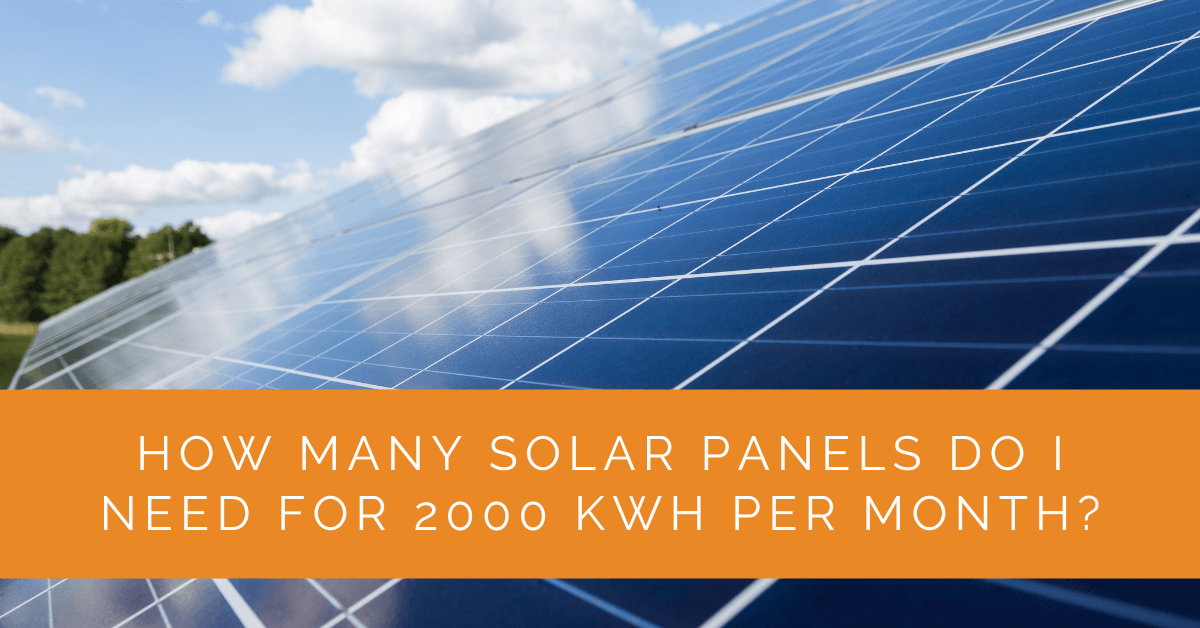As the demand for solar power grows, many individuals are interested in determining the number of solar panels required to meet their specific energy needs. In this article, we will investigate calculating the number of solar panels needed to generate 2000 kWh per month. Understanding the factors involved and using an accurate calculation method will help you size your solar system appropriately and harness the sun’s power effectively.
Contents
- 1 Key Takeaways
- 2 Understanding Solar Panel Output and Energy Consumption
- 3 Estimating Solar Panel Production and Energy Requirements
- 4 Factors Affecting Solar Panel System Performance
- 5 Determining the Number of Solar Panels
- 6 Case Study: Determining the Number of Solar Panels to Generate 2000 kWh per Month
- 7 Expert Insights From Our Solar Panel Installers About How Many Solar Panels Do I Need for 2000 kWh per Month
- 8 Experience Solar Excellence with Us!
- 9 Conclusion
Key Takeaways
- The number of solar panels required to generate 2000 kWh per month depends on various factors, such as panel wattage, sunlight availability, system efficiency, and location-specific conditions.
- For example, to generate 2000 kWh per month, a rough estimate would be approximately 16 to 25 solar panels with an average capacity of 300 watts each. However, the exact number may vary based on individual factors.
- Consulting with solar professionals, conducting an energy audit, and considering the specific requirements of your location can help determine the optimal number of solar panels needed to achieve your desired energy production.
Understanding Solar Panel Output and Energy Consumption
Solar Panel Output
When it comes to solar panel output, several factors impact their efficiency and performance. One crucial aspect is the type of solar panel technology used. Different types of solar panels are available, such as monocrystalline, polycrystalline, and thin-film panels. Each technology has advantages and disadvantages regarding efficiency, durability, and cost.
Monocrystalline panels, for example, are known for their high efficiency and sleek appearance. They are made from a single crystal structure, allowing them to convert sunlight into electricity more efficiently. On the other hand, polycrystalline panels are made from multiple crystal structures, which makes them slightly less efficient but more cost-effective.
Another factor influencing solar panel output is temperature. Solar panels perform best under specific temperature conditions. As the temperature rises, the efficiency of solar panels tends to decrease. Considering this when designing a solar panel system is essential to ensure optimal performance.
Additionally, shading can have a significant impact on solar panel output. Even partial shading of just a small solar panel section can significantly reduce its overall efficiency. It is crucial to carefully assess the installation location to minimize any potential shading issues caused by nearby trees, buildings, or other obstructions.
Energy Consumption
Understanding your energy consumption is vital when determining the number of solar panels required to meet your needs. Start by evaluating your monthly electricity bills to estimate your average kilowatt-hours (kWh) energy consumption. Take note of any seasonal variations or changes in energy usage throughout the year.
Next, identify the major energy-consuming appliances and devices in your home. These may include refrigerators, air conditioners, heating systems, lighting, and electronics. Determine each device’s power rating or wattage to calculate its energy consumption. Multiply the wattage by the number of hours each device is used daily to determine their daily energy usage. Summing up the daily energy usage of all devices will give you an estimate of your total daily energy consumption.
Remember that energy consumption can vary from month to month, so it is beneficial to analyze your energy usage over a longer period to obtain a more accurate average. By understanding your energy consumption patterns, you can better assess your solar panel requirements and design a system that meets your needs.
Estimating Solar Panel Production and Energy Requirements
Calculating Daily Energy Production
To estimate the daily energy production of solar panels, it is crucial to consider the availability of sunlight in your location and the concept of peak sun hours. Peak sun hours are the hours during the day when the sunlight intensity is strong enough for optimal solar panel performance.
You can consult solar radiation maps or databases specific to your region to determine the average number of peak sun hours in your area. These resources provide valuable information about the amount of solar energy received in different locations throughout the year.
Once you have an estimate of the average number of peak sun hours, you can calculate the daily energy production of your solar panels. Multiply the wattage of your solar panels by the average number of peak sun hours. This calculation will give you an estimate of the energy produced by your solar panels daily.
Determining Monthly Energy Requirements
While estimating daily energy production is essential, it is equally important to consider your monthly energy requirements. Multiply your average daily energy consumption by the number of days a month to estimate your total monthly energy consumption. This calculation accounts for variations in energy usage throughout the month and provides a more comprehensive picture of your energy needs.
Keep in mind that energy consumption can fluctuate seasonally due to factors such as climate, temperature, and changes in daily routines. For example, during the summer, energy consumption may increase due to higher air conditioning usage, while heating systems may contribute to higher energy demands in the winter. Considering these seasonal variations, you can ensure that your solar panel system is sized appropriately to meet your energy needs throughout the year.
It is also worth noting that some months may have more or fewer days than others. Adjust your calculations to account for these differences and obtain a more accurate estimate of your monthly energy requirements.
By understanding your monthly energy consumption and factoring in seasonal variations, you can better assess the energy production capabilities of your solar panels. This information will be crucial in determining the number of solar panels needed to achieve a monthly energy target of 2000 kWh.

Factors Affecting Solar Panel System Performance
Sunlight Availability and Location
The availability of sunlight and the geographic location of your solar panel system significantly impact its performance. The sunlight received in a particular location depends on latitude, climate, and local weather patterns.
Regions closer to the equator generally receive more sunlight throughout the year. In contrast, areas farther from the equator may experience more significant variations in sunlight intensity and duration due to seasonal changes. Understanding the sunlight availability in your location is vital when determining the number of solar panels needed to generate the desired energy output.
In addition to the latitude, consider any potential obstructions that may cast shadows on your solar panels. Nearby buildings, trees, or other structures can create shading, reducing the overall efficiency of the panels. Choosing an installation location with minimal shading is crucial to maximize solar exposure and optimize energy production.
Panel Orientation and Tilt Angle
Your solar panels’ orientation and tilt angle play a crucial role in their energy production. Solar panels in the Northern Hemisphere should typically face south for optimal performance, while in the Southern Hemisphere, they should face north. This orientation allows the panels to capture maximum sunlight throughout the day.
To further enhance energy production, adjusting the tilt angle of your panels based on your location’s latitude is recommended. By tilting the panels at an angle that aligns with your latitude, you can optimize their exposure to the sun’s rays throughout the year. This adjustment accounts for the changing angle of the sun as the seasons progress, maximizing energy absorption.
Consideration should also be given to the mounting structure and installation design. Ensuring the panels are securely mounted and correctly angled will prevent potential performance issues and ensure efficient energy generation.
Efficiency Losses and System Design
Efficiency losses can occur in a solar panel system due to various factors. Temperature, for instance, affects the efficiency of solar panels. As the temperature rises, the panels become less efficient in converting sunlight into electricity. It is important to select panels with good temperature coefficients and consider ventilation or cooling options to mitigate any adverse effects of high temperatures on panel performance.
Shading is another significant factor that can lead to efficiency losses. Even a small shading on a solar panel can greatly reduce its output. When designing your solar panel system, consider potential shading sources and position the panels to minimize shading during peak sunlight hours.
Proper system design is crucial for maximizing the performance of your solar panel system. This includes selecting high-quality components, such as inverters and wiring, that can handle the energy produced by your solar panels. A well-designed system will minimize energy losses and ensure your solar panels operate optimally.
By understanding the factors that affect solar panel system performance and taking them into account during the design and installation process, you can optimize the energy production of your solar panel system and achieve the desired monthly energy target.

Determining the Number of Solar Panels
When determining the number of solar panels needed to generate 2000 kWh per month, it is important to consider various factors and perform accurate calculations. By following these steps, you can ensure that your solar panel system meets your energy requirements effectively.
Panel Wattage and System Capacity
The wattage of solar panels and the desired system capacity are crucial factors in determining the number of panels needed. Solar panels come in different wattages, ranging from 250 to 400 watts. Higher-wattage panels can generate more electricity but may also be more expensive.
To calculate the number of panels needed, divide the desired system capacity by the wattage of each panel. For instance, if you aim for a system capacity of 2000 watts and your panels have a wattage of 300, you would need approximately 6.67 panels. You would need seven panels for your system to reach the nearest whole number.
Sizing the Solar Panel System
When sizing your solar panel system, consider both physical and energy-related factors. Evaluate the available space for panel installation, such as the roof area or designated ground space. Calculate the total surface area required based on the dimensions of each panel. Ensure that your installation area can accommodate the desired number of panels while maximizing exposure to sunlight.
Additionally, consider your energy needs and the system’s ability to generate sufficient power to meet those needs. To estimate the required panels, you can divide your monthly energy target of 2000 kWh by the average energy output per panel. This calculation estimates the minimum number of panels needed to achieve your desired energy production.
However, it’s important to note that this calculation represents the minimum number of panels required under ideal conditions. To account for factors such as inefficiencies, shading, and variations in sunlight availability, it is advisable to add extra panels to ensure adequate energy generation. Adding a buffer of a few additional panels will help compensate for potential losses and guarantee that your solar panel system can consistently produce the desired energy output.
Professional Consultation
While the steps mentioned above provide a general guideline for determining the number of solar panels needed, consulting with a professional solar installer or energy consultant is always recommended. These experts have the knowledge and experience to assess your specific energy requirements, evaluate your location, and design a solar panel system tailored to your needs.
A professional installer can also consider additional factors impacting your energy production, such as local weather patterns, shading analysis, and panel efficiency. They will perform precise calculations and simulations to determine the optimal number of panels needed for your situation.
By working with a professional, you can ensure accurate sizing of your solar panel system, maximize energy production, and optimize the return on your investment.
Case Study: Determining the Number of Solar Panels to Generate 2000 kWh per Month
Background
At Solar Panels Network USA, our mission is to provide tailored solar solutions that meet our clients’ specific energy needs. One of our recent projects involved designing a solar panel system to generate 2000 kWh per month for a residential client. This case study showcases how we accurately determined the number of solar panels required to meet this energy goal.
Project Overview
A homeowner in a sunny region approached us with the objective of generating 2000 kWh per month using solar energy. Their aim was to reduce electricity bills and minimize their carbon footprint. Our task was to calculate the optimal number of solar panels needed and design an efficient system.
Implementation
Understanding Energy Consumption:
We began by analyzing the client’s energy consumption. By evaluating their monthly electricity bills, we determined that their average consumption was 2000 kWh per month. This step was crucial for sizing the solar panel system accurately.
Estimating Solar Panel Output:
Next, we assessed the average daily sunlight in the client’s location using solar radiation maps. The region received an average of 5 peak sun hours per day. We selected high-efficiency 300-watt monocrystalline solar panels known for their high performance and durability.
Calculating Daily Energy Production:
To estimate daily energy production, we multiplied the wattage of each panel by the average number of peak sun hours. Each 300-watt panel produced approximately 1.5 kWh per day (300 watts x 5 hours = 1.5 kWh). To meet the monthly target of 2000 kWh, the system needed to produce around 66.7 kWh per day (2000 kWh / 30 days).
Determining the Number of Panels:
We divided the daily energy requirement by the daily energy production per panel to determine the number of panels needed. With each panel producing 1.5 kWh per day, approximately 45 panels were required (66.7 kWh / 1.5 kWh per panel = 44.5 panels). To ensure a buffer for potential inefficiencies and shading, we recommended 50 panels for optimal performance.
System Design and Layout:
The available roof space and orientation were carefully assessed to optimize panel placement and minimize shading. The panels were installed with a south-facing orientation at an optimal tilt angle to maximize sunlight exposure. High-efficiency inverters were selected to ensure minimal energy loss during conversion from DC to AC power.
Results
The solar panel system performed exceptionally well, consistently generating the required 2000 kWh per month. The client experienced significant reductions in their electricity bills and was pleased with the system’s reliability and performance. The high-efficiency panels and strategic layout design ensured maximum energy production, even on cloudy days.
Summary
Accurately determining the number of solar panels required to generate 2000 kWh per month involves understanding energy consumption, estimating solar panel output, and considering location-specific factors. At Solar Panels Network USA, we leverage advanced technologies and detailed assessments to provide customized solutions that meet our clients’ energy needs.
By using high-efficiency panels, optimal system design, and thorough analysis, we ensure that our solar installations maximize energy production and efficiency. This approach not only helps clients achieve their energy goals but also contributes to a sustainable future by harnessing the power of the sun effectively.
Expert Insights From Our Solar Panel Installers About How Many Solar Panels Do I Need for 2000 kWh per Month
Calculating the average daily energy consumption is the first step. It helps in estimating the number of panels needed to meet your monthly energy targets.
Senior Solar Technician
Panel efficiency and proper system design play significant roles. High-efficiency panels and optimal placement can reduce the number of panels needed while maximizing energy production.
Lead Solar Installer
Considering location-specific factors like sunlight availability and potential shading is essential for accurate calculations. Consulting with professionals ensures all variables are properly accounted for.
Certified Solar Engineer
Experience Solar Excellence with Us!
Trust in Solar Panels Network USA, where our seasoned experts deliver top-quality solar solutions for homes and businesses nationwide. With a legacy of countless successful installations and a commitment to sustainable energy, we’re your reliable partner in the solar journey. Ready for a brighter, eco-friendly future? Call us now at (855) 427-0058 and harness the power of the sun!
Conclusion
Determining the number of solar panels needed to generate 2000 kWh per month requires careful consideration of various factors. Understanding solar panel output, energy consumption, location-specific sunlight availability, and system design considerations is key to accurately sizing your solar panel system.
By estimating the daily energy production of a solar panel, calculating your monthly energy requirements, and considering factors that affect system performance, you can determine the number of panels required to meet your energy goals. It’s also important to consult a professional solar installer who can provide expert guidance and design a customized solar panel system tailored to your needs.
Investing in solar panels allows you to generate clean and renewable energy, offers long-term cost savings, and reduces your carbon footprint. Take advantage of the abundant energy provided by the sun and embark on a sustainable journey toward a greener future.
About the Author
Solar Panels Network USA stands at the forefront of solar energy solutions, driven by a team of seasoned solar engineers and energy consultants. With over decades of experience in delivering high-quality solar installations and maintenance, we are committed to promoting sustainable energy through customer-centric, tailored solutions. Our articles reflect this commitment, crafted collaboratively by experts to provide accurate, up-to-date insights into solar technology, ensuring our readers are well-informed and empowered in their solar energy decisions.

